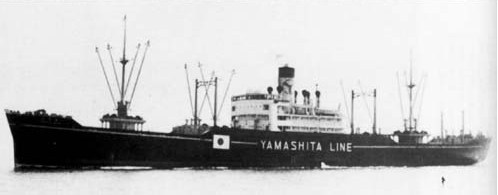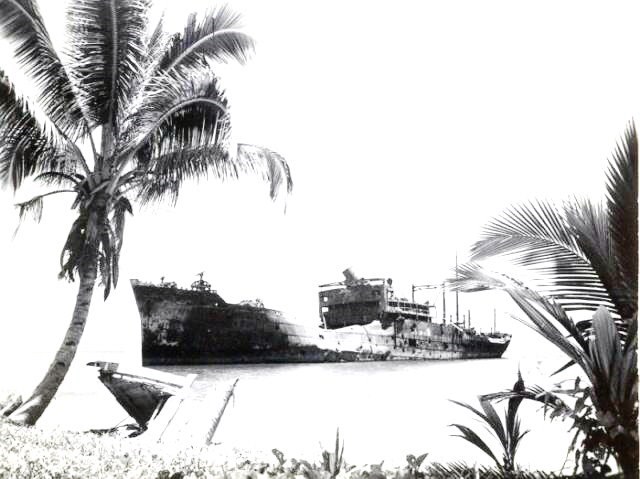RIKUGUN YUSOSEN
 (Sister YAMABIKO MARU, prewar)
(Sister YAMABIKO MARU, prewar)
YAMAURA MARU:
Tabular Record of Movement
© 2014-2017 Bob Hackett
28 July 1937:
Uraga. Laid down at Uraga Dock Co. as Yard No. 418, a 6,798-ton cargo ship for Yamashita Kisen (Steamship Co.), K. K. of Kobe.
30 November 1937:
launched and named YAMAURA MARU.
2 March 1938:
Completed and placed in service on Yamashita Kisen’s routes.
15 May 1939:
YAMAURA MARU arrives at the Panama Canal.
30 November 1939:
YAMAURA MARU arrives at Buenos Aires, Argentina
carrying Jewish immigrants from wartime Europe.
8 November 194 :
Requisitioned by the Imperial Army (IJA) and converted to a troop transport. Allotted Army No. IJA No. 970.
12 January 1942:
YAMAURA MARU departs Hong Kong in an Invasion Force also consisting of AFRICA, MIIKE, RYOYO and ZENYO MARUs, carrying 5,300 men of
MajGen Ito Takeo’s 38th Infantry Group consisting of Headquarters & supporting units, 3rd Battalion, 228th Infantry Regiment, main force of 1st Mountain Artillery Battlaion, 1st Battalion, 228th Infantry Regiment and 2nd
Battalion, 228th Infantry Regiment.
29-31 January 1942: The Invasion of Ambon Island, Ceram Island. Moluccas, Netherlands East Indies:
At midnight, YAMAURA MARU departs Bangka anchorage, near Menado, with the Ambon invasion convoy also consisting of transports AFRICA, HINO, KATSURAGI, KIRISHIMA, MIIKE, RYOYO, YAMAFUKU, YAMAGIRI and ZENYO MARUs carrying Rear Admiral (later Vice Admiral) Hatakeyama Koichiro's (39) (former CO of KINUGASA) No. 1 Kure Special Naval Landing Force (SNLF), elements of the Sasebo SNLF and the 228th Infantry Regiment. YAMAURA MARU carries the 2nd Battalion, 228th Infantry Regiment, 38th Division.
Escort is provided by Rear Admiral (later Vice Admiral) Tanaka (41)'s DesRon 2’s light cruiser JINTSU, DesDiv 8’s ASASHIO, MICHISHIO, ARASHIO and OSHIO, DesDiv 15’s HAYASHIO, KUROSHIO, OYASHIO and NATSUSHIO, DesDiv 16’s TOKITSUKAZE, HATSUKAZE, AMATSUKAZE and YUKIKAZE, MineSweepDiv 11’s W-7, W-8, W-9, W-11 and W-12, SubChasDiv 1’s CH-1 and CH-2, and Patrol Boat Squadron 1’s PB-34. Seaplane tenders CHITOSE and MIZUHO arrive at Ceram and provide air cover for the invasion convoy.
Landings proceed during the night of Jan 30-31 by the No. 1 Kure SNLF at Hitu-Iama on the North coast, and by the IJA’s 228th Infantry Regiment on the southern coast of Laitamor. The defenders are at a disadvantage to contest the landings as only a few Dutch detachments are in the area. At Hitu-Iama on the north coast, the defending infantry and machine-gun crews are quickly overwhelmed and bridges on the road leading to Paso are left intact allowing the Japanese to speedily advance south across the Hitu Peninsula.
Other landings occur around Hutumori where the Japanese split westward to the town and northward to Paso. The Japanese compel captured Ambonese to act as guides. The Japanese pass through a gap in the south at Batugong that falls on Jan 31st.
3 February 1942:
Ambon is secured.
17 February 1942: The Invasion Timor Island:
Timor is divided into two separate colonies governed by Holland and Portugal. Portugese East Timor is neutral, still Japan decides to invade. The IJA is responsible for the landings at Kupang, Dutch West Timor. The IJN is responsible for the landings at Dili on the Portuguese NE coast of the island.
At 0500, YAMAURA MARU departs Ambon for Koepang, Dutch Timor in an invasion convoy also consisting of transports transports AFRICA, MIIKE, RYOYO and ZENYO MARUs escorted by DesDiv 24's KAWAKAZE and YAMAKAZE, patrol boats PB-1, PB-2 and PB-34, MineSweepDiv 21's W-7 and W-8, and a subchaser. En route, KUNIKAWA MARU joins the convoy from Kendari, Celebes (Sulawesi).
The Timor invasion convoy carries the IJA’s 38th Div’s 228th Infantry Regiment and an IJN Special Naval Landing Force (SNLF). CruDiv 5's HAGURO and NACHI, DesDiv 6's INAZUMA and IKAZUCHI and DesDiv 7's AKEBONO provide distant cover. Air cover is provided by seaplane carrier MIZUHO.
18 February 1942:
At 0230, the 2nd Echelon consisting of IJA
transport YAMAURA MARU temporarily under the control of the IJN, fast transport
(converted destroyer) PB-34 and four unidentified transports departs Ambon for
Portuguese East Timor escorted by Rear Admiral (later Vice Admiral) Tanaka
Raizo’s DesRon 2 JINTSU (F) and DesDiv 7’s USHIO and SAZANAMI. Air cover is
provided by Mitsubishi F1M2 “Pete” floatplanes from the seaplane carrier MIZUHO.
Enroute, they are joined by IJN transport NISSHUN MARU from Kendari.
19 February 1942: That night, both convoys arrive off Timor. Operating as
part of the American-British-Dutch-Australian ABDA FLOAT, the U. S. Asiatic
Fleet's USS PIKE (SS-173) under under LtCdr William A. New (USNA ’25), LtCdr
Lewis Wallace's (USNA ’25) TARPON (SS-175) and LtCdr B. E. Bacon's (USNA ’25)
PICKEREL (SS-177) make contact with the invasion force.
20 February 1942:
Dutch West Timor. At 0235, landings begin on the
east and west sides of Cape Mali coast. By 0315, the landings are completed
without resistance. The Kupang force then heads over the mountains towards
Kupang. At 1030, An unknown number of transport planes drop LtCdr Fukumi
Koichi’s No. 3 Yokosuka SNLF paratroops 4 km NW of Babau. Alor island. At 0243,
USS PIKE attacks what LtCdr New misidentifies as two "light cruisers". The
ships, in fact, are W-7 and W-8. New fires two torpedoes from 4,000 yards, but
they miss ahead. The minesweepers move out of range before New can set up for
another attack.
Portuguese East Timor. At 0030, the 2nd Echelon arrives 1 km NW of Dili.
Landings begin, but fierce resistance is encountered. Destroyers USHIO and
SAZANAMI take the enemy positions under fire. Because of the resistance, the
landing craft head westward. At 0218, landings begin at the mouth of the Carmona
River. By 1100, Buton airfield is captured and by 1230 Dili Town is also
captured.
24 February 1942:
At 1500 YAMAURA MARU departs Dili in a convoy also
consisting of KASUGA MARU escorted by patrol boats PB-1 and PB-2.
25 February 1942:
At 0700, the convoy arrives at Kupang.
28 May 1942:
At 0900, YAMAURA MARU departs Hesaki south through the
Bungo Straits in a convoy also consisting of NAGARA, OTOWASAN and RYOYO, MARUs
escorted by minelayer NASAMI.
2 October 1942:
YAMAURA MARU arrives at Rabaul, New Britain in an
unidentified convoy probably also consisting of BRISBANE, NAKA, SHINANOGAWA and
YAMAZUKI MARUs and several unidentified ships with an unknown escort
12 November 1942:
YAMAURA MARU departs Shortlands for Guadalcanal,
Solomons with Rear Admiral (later Vice Admiral) Tanaka Raizo's Reinforcement
Group’s troop transports carrying Maj Gen Tanabe Suketomo's 38th Army ("Sendai")
Division and Special Naval Landing Force (SNLF) troops, equipment and provisions
in the No. 2 Butai also consisting of ARIZONA, BRISBANE, KINUGAWA, SHINANOGAWA
and YAMAZUKI MARUs accompanied by the No. 1 Butai consisting of CANBERRA,
HIROKAWA, NAGARA, NAKO and SADO MARUs all escorted by DesRon 2’s AMAGIRI,
HAYASHIO, KAGERO, KAWAKAZE, MAKINAMI, MOCHIZUKI, NAGANAMI, OYASHIO, SUZUKAZE,
TAKANAMI and UMIKAZE. No. 2 Butai is to unload at Argulio Point, near Cape
Esperance while the faster No. 1 Butai is to unload at Tassafaronga.
The convoy is scheduled to arrive at Guadalcanal that night, but is
recalled back to Shortland, due to the “First Naval Battle of Guadalcanal” that
day that resulted in the disabling (and later sinking) of battleship HIEI,
sinking of destroyer AKATSUKI, disabling of destroyer YUDACHI and damage to
destroyers AMATSUKAZE and MURASAME.
13 November 1942:
At 1730, YAMAURA MARU again departs Shortlands for
Guadalcanal, Solomons with Rear Admiral (later Vice Admiral) Tanaka Raizo's
Reinforcement Group’s ten other troop transports and 11 destroyers. Air cover is
provided by the 11th Air Fleet and the R-Area Air Force's floatplane fighters.
14 November 1942:
At 0849, as Tanaka's Reinforcement Group proceeds
down the "Slot" between the New Georgia and Santa Isabel Islands, the 23-ship
convoy is sighted by two reconnaissance Douglas "Dauntless" SBD dive-bombers
from USS ENTERPRISE (CV-6). At 0908, the SDBs each attack a transport, but miss.
One SBD is shot down by Japanese fighters.
N of Guadalcanal. At 1250, 18 Marine Corps SBD dive-bombers and seven USN
Grumman "Avenger" TBF torpedo-bombers of VT-10 attack the convoy. Mitsubishi
A6Ms shoot down some aircraft, but are engaged by Grumman F4F "Wildcat" fighters
and cannot stop the attack. NAGARA MARU is torpedoed and CANBERRA MARUs is
bombed and sunk. The Americans also damage cargo ship SADO MARU that is detached
to Shortlands with AMAGIRI and MOCHIZUKI carrying among other survivors, MajGen
Tanabe Suketomo, CO of the IJA’s 38th Division and other survivors.
At about 1430, SBD dive-bombers from ENTERPRISE and USMC SBDs of the
"Cactus Air Force" at Henderson Field, Guadalcanal make another attack and set
BRISBANE MARU ablaze until she later sinks by the stern at 08-58S, 159-06E
Destroyer KAWAKAZE rescues 550 survivors. [1]
The remaining four transports YAMAURA, HIROKAWA, KINUGAWA and YAMAZUKI
MARU and four destroyers continue towards Guadalcanal. After nightfall, they
stop west of Guadalcanal, awaiting the conclusion of the Second Naval Battle of
Guadalcanal during the night of 14-15 November.
15 November 1942: The Second Naval Battle of Guadalcanal:
At 0025,
Vice Admiral (later Admiral) Kondo Nobutake (35) (former CO of KONGO), Deputy
Commander of the Combined Fleet, after losing battleship KIRISHIMA, orders “all
units to attack” two enemy battleships 6 miles north of Cape Esperance,
Guadalcanal.
Prior to receipt of Kindo’s order, Rear Admiral Tanaka already had
detached Des Div 15’s OYASHIO and KAGERO with orders to attack any American ship
closing the convoy. At 0033, Rear Admiral (later Vice Admiral) Willis A. Lee
(USNA ’04) aboard Task Force 64’s new battleship USS WASHINGTON (BB-56) spots
the Japanese destroyers laying a smoke screen close ahead to starboard.
WASHINGTON’s CO, Captain (later Vice Admiral) Glenn B. Davis (USNA ’13), orders
a hard starboard turn to avoid the risk of a torpedo attack in the smoke. Lee
orders WASHINGTON to continue the turn and retire southward.
Admiral Kondo orders Tanaka to beach his troop convoy at Tassafaronga.
At, 0051, Tanaka’s remaining four transports get underway from an anchorage
where they had taken refuge during a squall. By about 0400, HIROKAWA and
KINUGAWA MARU’s captains’ beach their ships in the mouth of the Bonegi River
near Tassafaronga. YAMATZUKI MARU is beached at Aruligo Point. YAMAURA MARU’s
captain runs her aground in Doma Cove at 08-58S, 159-06E.
By dawn, about 2,000 troops aboard the transports make shore.
 (YAMAURA MARU, still beached at Tassafaronga in 1944)
(YAMAURA MARU, still beached at Tassafaronga in 1944)
Author's Notes:
[1] The Japanese lose about 450 men KIA in the 14 Nov '42
action, although troop losses and other casualties for individual ships are
unknown. Altogether, the destroyers rescue more than 4,700 men.
Thanks go to Erich Muehlthaler of Germany.
Bob Hackett
Back to IJA
Transports






